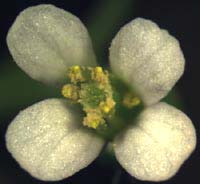Sophisticated silencing strategies

Since small RNA molecules were discovered just over ten years ago, it has become clear that these once overlooked bits of genetic material play a decidedly large role in controlling gene expression and thus regulating a diverse array of cellular processes. They typically accomplish these tasks by targeting specific nucleotide sequences to shut down gene expression, and scientists are now starting to apply related strategies to inactivate specific genes for research and therapeutic purposes (see related feature article by Richard Robinson at http://www.plosbiology.org/plosonline/?request=get-document&doi=10.1371/journal.pbio.0020028).
Yet much remains to be learned about the details of small-RNA-mediated silencing, and a study lead by James Carrington (Oregon State University) and Steve Jacobsen (UCLA) now demonstrates that plants have evolved multiple systems to produce distinct classes of small RNAs with specialized functions. These include genome maintenance, the regulation of specific endogenous target genes, and defense against viral and transposon sequences. These results shed light on the evolution of RNA-mediated gene silencing and have implications for the adaptation of such silencing strategies for various purposes.
Citation: Xie Z, Johansen LK, Gustafson AM, Kasschau KD, Lellis AD, et al. (2004) Genetic and functional diversification of small RNA pathways in plants. PLoS Biol 2(5): e104 DOI: 10.1371/journal.pbio.0020104
CONTACTS:
James Carrington
Oregon State University
Corvallis, OR 97331
United States of America
541-737-3686
carrington@orst.edu
Steven Jacobsen
University of California, Los Angeles
Los Angeles, California 90095-1606
United States of America
310-825-0182
jacobsen@ucla.edu
This article is presented as a pre-issue publication. It will be part of our May 2004 issue.
Media Contact
All latest news from the category: Life Sciences and Chemistry
Articles and reports from the Life Sciences and chemistry area deal with applied and basic research into modern biology, chemistry and human medicine.
Valuable information can be found on a range of life sciences fields including bacteriology, biochemistry, bionics, bioinformatics, biophysics, biotechnology, genetics, geobotany, human biology, marine biology, microbiology, molecular biology, cellular biology, zoology, bioinorganic chemistry, microchemistry and environmental chemistry.
Newest articles

Machine learning algorithm reveals long-theorized glass phase in crystal
Scientists have found evidence of an elusive, glassy phase of matter that emerges when a crystal’s perfect internal pattern is disrupted. X-ray technology and machine learning converge to shed light…

Mapping plant functional diversity from space
HKU ecologists revolutionize ecosystem monitoring with novel field-satellite integration. An international team of researchers, led by Professor Jin WU from the School of Biological Sciences at The University of Hong…

Inverters with constant full load capability
…enable an increase in the performance of electric drives. Overheating components significantly limit the performance of drivetrains in electric vehicles. Inverters in particular are subject to a high thermal load,…





















